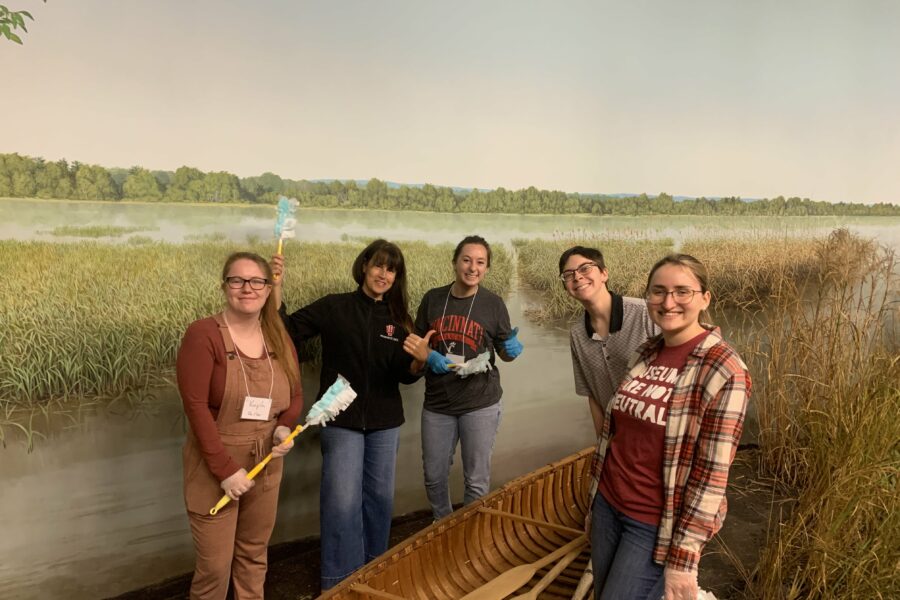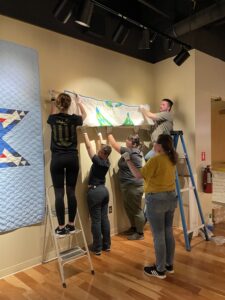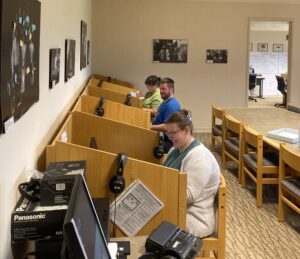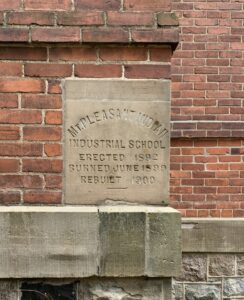
By Marissa Hamm
“…the Ziibiwing Center staff, both past and present, hold a collective sense about Ziibiwing’s creation. It is a ‘community project’–a ‘we’ effort instead of an individual one.” (Lonetree 2012, 129)
During the first day of class, Dr. Holly Cusack-McVeigh made two things clear: one, we would come to know one another well during this class, and two, if we were open-minded, this could be an impactful and even life-changing experience. She was not wrong. Over the course of eight weeks in the spring semester, I participated in Community Collaboration and Curation with seventeen other Museum Studies, Anthropology, and History students. In this course, we had the unique opportunity to visit the Ziibiwing Center of Anishinabe Culture and Lifeways in Mt Pleasant, MI, and assist with Dr. Cusack-McVeigh’s ongoing collaboration with the Saginaw Chippewa tribe. After a four year, COVID-induced hiatus from visiting Ziibiwing, the return of the Community Collaboration and Curation course this semester was a resounding success that I am thankful to have been a part of.

Students de-install quilts in the temporary exhibit at Ziibiwing (April 21, 2023). Pictured left to right: Aubrey Miles, Syd Overtoom, Hailey Barrow, Ava Osowick, and Gregory Walker.
In the six weeks leading up to our trip to Ziibiwing, we spent time learning about the Anishinaabe in the past, present, and future to prepare us to work within this community. Through films, readings, and classroom discussions with special guests, we focused on the ongoing effects of colonization in Anishinaabe communities and read several traditional tales from Anishinaabe culture. The most important part of this preparatory work was that every lesson came from indigenous voices since community collaborators should learn about the community directly from its members, not outsiders who have “studied” the community. In addition to learning about the Anishinaabek, we had lessons in important collections practices including how to properly handle objects and identify pests since most of our work at Ziibiwing would be working with their museum collections.
Equipped with our series of trainings, we headed to Mt. Pleasant in late April for a three day visit to Ziibiwing. Our first day began with a blessing and smudging of the room led by Willie Johnson, Ziibiwing’s fearless leader and long-time curator. Immediately, the warmth from Willie and the other Ziibiwing staff was palpable and made us all feel at ease. After Willie shared a few words with us, we split into our groups and got to work on our tasks for the weekend.

Students working in the archives (April 22, 2023). Pictured front to back: Shelby Riley, Gregory Walker, and Hailey Barrow.
Students had the choice of six projects, although we were encouraged to dabble in multiple projects throughout the two working days. Some students worked in the temporary exhibit space de-installing the exhibition of quilts on loan from Michigan State University, building custom boxes to securely store artwork from the collection, and completing condition reports on a large collection of Black Ash baskets that the museum recently acquired. Other students gravitated towards the archives where they processed student case files from the Mt. Pleasant Indian Industrial Boarding School that the National Archives in Chicago are digitizing and sending to Ziibiwing. The rest of the students worked with Dr. Cusack-McVeigh in the galleries of the museum’s permanent exhibit Diba Jimooyung to systematically clean and inspect the many exhibit cases for signs of pest damage.

Students measure a basket for condition reporting (April 21, 2023). Pictured left to right: Monique Hochstetler and Morgan Coffman.
One final task fell to myself and a fellow classmate to work with Willie and Nathan, the Center’s fundraiser, to re-design the Ziibiwing rack card which appears in rest stops and other sites throughout Michigan to promote Ziibiwing. This project later morphed into a full re-organization of the Ziibiwing marketing closet – a task that Willie was thrilled to complete as it will help the Ziibiwing staff to quickly find materials they need instead of searching through unmarked boxes.
After two intensive, exhausting, and rewarding days helping out at the Ziibiwing Center, our third and final day was slower. Our morning began with a shared breakfast and gift-giving ceremony. For this ceremony, each student and professor approached a red blanket laid out in the middle of the room with their offering and explained why they chose this gift to give to the Saginaw Chippewa community. Gifts ranged from handmade blankets and muffins to a large stuffed parrot and megaphone. The stories each person told as they gave their gift imbued these objects with new meanings allowing Willie to then communicate how the gift would be used in the community. This thoughtful, emotional process was a touching close to our time spent at Ziibiwing.

View of building at Mt Pleasant Indian Industrial Boarding School (April 23, 2023).
Before we officially left Mt Pleasant, we took one final trip to see the Mt. Pleasant Indian Industrial Boarding School. In our preparation for visiting Michigan, we spent a great deal of class time learning about the Indian boarding schools, a system that was central to the U.S. government’s “process of cultural genocide against Native cultures…designed to physically, ideologically, and emotionally remove Indian children from their families, homes, and tribal affiliations” (Archuleta, Child, and Lomawaima 2000, 19). Visiting the ruins of the school and hearing Willie’s explanation of how students were treated there and how he and others in the community are now actively working to study and preserve this site was difficult. Even more devastating was visiting the cemetery nearby where a few headstones mark the graves of children who perished at the school, although there are likely many more unmarked graves yet to be discovered nearby. After this emotional experience, Willie sent us on our journey home by gathering us in a circle and then walking around and speaking Ojibwe words of safe travels and giving one another a hug. This final act was a fitting way to close a trip that deepened our connections to one another and to the Saginaw Chippewa community at Ziibiwing.
Since returning from Ziibiwing, I have spent many hours reflecting on and appreciating this special experience. Throughout this class and trip, I gained a deeper understanding of the history of indigenous cultures in the U.S. and how tribal communities persist in the present-day. I also experienced firsthand what it means to work in and for a community and what it means to be a good listener and collaborator. This experience brought me closer to my classmates and made me more determined to be an ethical and empathetic museum practitioner as I graduate from my time at IUPUI and start my museum career.
Marissa Hamm is a 2023 graduate of the Museum Studies MA Program.
The spring 2023 Community Collaboration and Curation course was supported by the IUPUI Center for Research and Learning, the IUPUI Institute for Engaged Learning, and the IUPUI Arts & Humanities Institute.
Works Cited
Archuleta, Margaret L., Brenda J. Child, and K. Tsiannia Lomawaima. 2000. “Part One: A Uniform Course of Study.” Away from Home: American Indian Boarding School Experiences edited by. Santa Fe: Museum of New Mexico Press.
Lonetree, Amy. 2012. Decolonizing Museums: Representing Native America in National and Tribal Museums. Chapel Hill: University of North Carolina Press.

